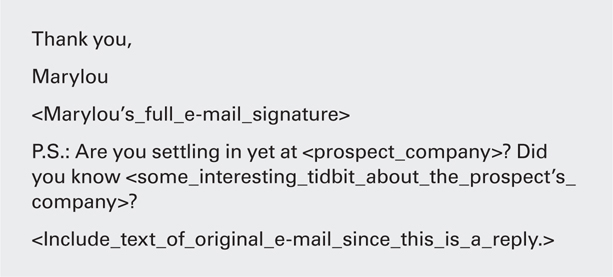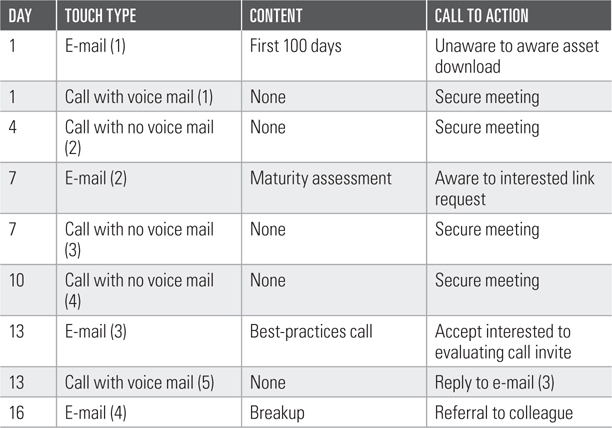APPENDIX
Quick Guide to Predictable Prospecting
In this book, we explain the what, why, and how of countless immediately actionable best practices and templates designed to make your prospecting predictable. However, we recognize that many readers, particularly sales development professionals, crave a quick summary, especially of our advice on crafting messaging and designing multitouch, multichannel campaigns.
To address this need, this appendix demonstrates how one of us (Marylou, an independent sales process consultant) would apply the framework to engage the other (Jeremey, a sales operations leader at a midsized information services company).
Step 1. Build a Six-Factor SWOT Analysis
Marylou must have a strong understanding of why prospects should buy from her rather than from the competition to position her sales process consulting services successfully.
To express her differentiated value propositions, she constructs a SWOT (strengths, weaknesses, opportunities, and threats) analysis consisting of the 4 Ps (product, price, promotion, and place); reputation and internal resources; external forces; trends; and VUCA (volatile, uncertain, complex, and ambiguous) factors. Boiling down her analysis to the three to five highest-impact factors, Marylou produces the SWOT analysis in Table A-1.
TABLE A-1 SWOT Analysis for Marylou’s Sales Strategy Consultancy

Step 2. Develop an Ideal Account Profile (IAP)
The ideal accounts for Marylou to target in an outbound prospecting campaign are those that not only value her differentiation (from Step 1) but also offer the maximum return on effort, vis-à-vis a high likelihood of buying and a high lifetime value. Considering firmographic, operational, and situational factors, she constructs the IAP in Figure A-1.
FIGURE A-1 IAP for Campaign Targeting Information Services Companies

Step 3. Craft an Ideal Prospect Persona (IPP)
In Step 2, Marylou identified the right companies to target. Now she needs to determine the right types of people. She does this with the help of the Ideal Prospect Persona (IPP) shown in Table A-2.
TABLE A-2 IPP for Sales Operations Professionals

Step 4. Craft Compelling Messaging
Crafting messaging that helps the seller identify where the prospect is in her buying journey is one of the central tenets of the Predictable Prospecting methodology. To that end, Marylou constructs the following prospecting e-mails:
![]() From unaware to aware (see Figure A-2)
From unaware to aware (see Figure A-2)
![]() From aware to interested (see Figure A-3)
From aware to interested (see Figure A-3)
![]() From interested to evaluating (see Figure A-4)
From interested to evaluating (see Figure A-4)
![]() Breakup and referral (see Figure A-5)
Breakup and referral (see Figure A-5)
![]() From evaluating to purchase (see Figure A-6)
From evaluating to purchase (see Figure A-6)
Additionally, the e-mails demonstrate taking a highly personalized approach to prospecting, which is increasingly necessary.
FIGURE A-2 Unaware to Aware Prospecting E-mail


FIGURE A-3 Aware to Interested Prospecting E-mail


FIGURE A-4 Interested to Evaluating Prospecting E-mail

FIGURE A-5 Breakup and Referral Prospecting E-mail

Note: The evaluating to purchase e-mail in Figure A-6 assumes that Marylou is well down the sales cycle with Jeremey.
FIGURE A-6 Evaluating to Purchase Prospecting E-mail

Step 5. Design a Multitouch, Multichannel Cadence
With messaging in hand, Marylou next designs a multitouch, multichannel cadence designed to secure an introductory meeting with Jeremey. Her cadence, illustrated in Table A-3, relies on e-mails and phone calls.
TABLE A-3 Outbound Campaign with Nine Touches in 16 Business Days

Step 6. Attempt to (Dis-)Qualify Prospects
Assuming Marylou secures a first meeting with Jeremey, she should work to determine, Are we a fit (AWAF)? AWAF works both ways since it is not only important for the prospect to see value but it is also critical for the salesperson to weed out (disqualify) prospects who are either unlikely to buy or unlikely to realize value after they buy. To accomplish this, Marylou must apply the must-have operational and situational criteria she established in the Ideal Account Profile (IAP from Step 2). To recap:
![]() Frustrated with inconsistent sales prospecting process
Frustrated with inconsistent sales prospecting process
![]() Unable to generate sales qualified opportunities consistently and predictably
Unable to generate sales qualified opportunities consistently and predictably
![]() Don’t know what metrics to measure, when to measure, and how to measure
Don’t know what metrics to measure, when to measure, and how to measure
![]() Sales leadership transition
Sales leadership transition
![]() Separation of sales roles; no business development process in place
Separation of sales roles; no business development process in place
![]() New market, new product, or new vertical to deploy in outreach channel
New market, new product, or new vertical to deploy in outreach channel
With AWAF completed, she can progress through more traditional opportunity qualification. The Predictable Prospecting framework relies on a resequencing of BANT into the following order: need, timing, authority, and budget. At a minimum, Marylou plans to ask Jeremey the following:
![]() Need: What are your primary performance objectives? How do you rank each in terms of importance?
Need: What are your primary performance objectives? How do you rank each in terms of importance?
![]() Timing: Where does improving sales productivity rank in your overall priorities?
Timing: Where does improving sales productivity rank in your overall priorities?
![]() Authority: In addition to you, who else in your organization is responsible for improving sales productivity?
Authority: In addition to you, who else in your organization is responsible for improving sales productivity?
![]() Budget: How is funding for a project like this determined?
Budget: How is funding for a project like this determined?
Step 7. Block Time for Prospecting
This book contains many frameworks for successful prospecting. But all of them will fail unless you set and adhere to daily calendar blocks dedicated to prospecting. For full-time sales development reps, we recommend four 90-minute slots. Table A-4 provides a recommended daily calendar for a full-time sales development representative with a daily goal of five to six hours of uninterrupted prospecting time.
TABLE A-4 Recommended Daily Calendar for Full-Time Sales Development Representative

